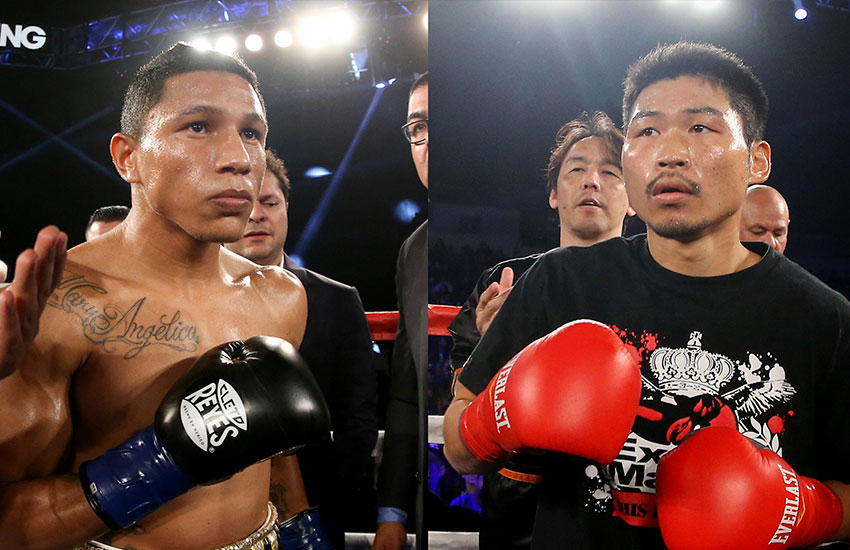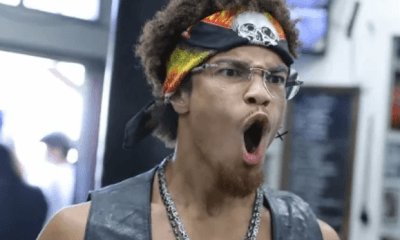Featured Articles
Back to Back Boxing Jewels in Southern California This Weekend

Once again summer means the Southern California landscape will be sizzling with fight cards from Montebello to Inglewood.
Perhaps the most curious of the cluster of fights takes place at the Forum in Inglewood on Saturday July 15. HBO will televise but only a few. It would be better to watch in person with two world title fights and an elimination light heavyweight clash in place.
But first let’s look at Friday night.
It’s been several years now since Golden Boy Promotions began staging regular fight cards at Belasco Theater in downtown Los Angeles. It’s been the jewel of all fight cards in Southern California.
Not since the glory days of the Olympic Auditorium from the 1930s to the 1980s has a regular boxing series taken hold like the Belasco series.
During the glory days the Olympic had a weekly series of boxing cards that brought everyone from Henry Armstrong to Danny “Li’l Red” Lopez headlining the old boxing palace.
The late Bennie Georgino, who managed Lopez and Alberto Davila, used to lament the loss of the weekly boxing series at the Olympic. Back in the 50s and 60s Georgino had a sandwich shop located right across the street from the now defunct Herald-Examiner newspaper. Ironically, the old newspaper building is across the street from the Belasco Theater.
During boxing’s heyday when newspapers actually had beat reporters covering the sport and competing for headlines, there were more than five daily newspapers battling in Los Angeles. It was in the 1960s that the Times and Mirror merged along with the Herald and Examiner merging too.
“Boxing will never return to Los Angeles,” Georgino would tell me often. But it has returned.
On Friday, another roster of talented youngsters are showcased at the old downtown theater.
Belasco
A co-main event features Edgar Valerio (10-0, 6 KOs) a tall featherweight from Los Angeles meeting Torreon, Mexico’s Jairo Ochoa (18-11, 9 KOs) in an eight round bout.
Valerio, 22, is managed by Joel De La Hoya and at first was fighting at bantamweight but now at 126 pounds and has gained power with the extra weight. He’s fearless and has lofty goals.
“I’ve never seen anyone work harder,” said De La Hoya of Valerio. “I know you need that kind of work ethic to go far. I watched my brother (Oscar De La Hoya) during his entire career and that’s what it takes to go to the top. Nobody worked harder.”
Another to watch on the card is Joshua Franco (11-0, 6 Kos) who began at bantamweight but has lately fought as a super flyweight and faces Antonio Rodriguez (11-16-1).
Franco, 21, a San Antonio, Texas native, trains in Riverside under the guidance of Robert Garcia. Every time he enters the boxing ring he seems to get better and better. He kind of reminds me of a smaller version of Mikey Garcia with his ability to set up punches and opponents. I’m sure being around Mikey Garcia has influenced more than a few of Franco’s moves.
Forum
On Saturday a fight card co-promoted by various major promoters opens up the Forum for a heavy duty-affair.
Back in the 70s when it was called the Fabulous Forum, some of the best boxing cards took place including my own favorite Mexican versus Mexican clash, Carlos Zarate (45-0, 44 KOs) versus Alfonso Zamora (29-0, 29 KOs). It was called the Battle of the ZZZ Boys. The two Mexican bantamweight champions were undefeated and had a combined 73 knockouts in 74 pro fights. It was a ridiculous percentage of knockouts. That day on April 23, 1977, Zarate put Zamora to sleep in the fourth round. Riots erupted, cherry bombs were lit, a wrestler entered the ring to challenge anyone and both trainers of Zarate and Zamora ended up throwing blows with each other.
Hopefully we don’t repeat the riot but see the knockouts. Expect several knockouts on Saturday.
One surefire firecracker of a fight will be WBC super featherweight titlist Miguel Berchelt (31-1, 28 KOs) defending against the former titleholder Japan’s Takashi Miura (31-3-2, 24 KOs) in the main event.
If you follow boxing than you must know about the intense rivalry Japan and Mexico have had in the boxing ring for decades. The first boxing match I ever attended at the Olympic was a Japan vs Mexico rivalry when Sho Saijo defeated Jose Pimentel on March 21, 1968. They fought each other three times with Saijo winning the world title on their third encounter.
Once again we have a Japanese warrior in Miura. This guy has been involved in two all-time classics. The first was in August 2013 when he and Sergio “Yeyo” Thompson met in 100 degree heat inside a bull ring in Cancun. It was stifling in that arena and both Miura and Thompson fought to near death. Each floored the other and the fight changed momentum several times. Finally, Miura emerged the winner by unanimous decision after an incredible 12 rounds. In November 2015, Mexico’s Francisco Vargas challenged Miura and both clashed like two pit bulls. Miura nearly knocked out Vargas in the fourth round and then was near a knockout win when Vargas surprised him and stopped the Japanese champion in the ninth round. In his last fight, Miura dazed another Mexican warrior, Miguel Roman, with a paralyzing body shot and then mercilessly bombed him with blows for a knockout.
Miura is one hard man.
“This will be my third fight in the United States, and I feel comfortable in getting myself acclimated to the time difference. I am looking forward to being on HBO again and putting on an exciting fight for the boxing fans,” said Miura. “If I am able to get the belt back Saturday, and the opportunity is there, I would want to unify the belts in the super featherweight division.”
Now we have Berchelt whose fight against Francisco Vargas last January could be the Fight of the Year for 2017. Both exchanged blows that left the audience dumbfounded by the sheer violence. It’s one of the reasons that Golden Boy matchmaker Robert Diaz recently won an award for his talented pairings. The Berchelt-Miura fight just might bump off the January affair. It’s a fight you have to see in person to appreciate.
“This by no means will be an easy fight – Miura has gone to war many times in his career and I am expecting nothing less in this fight,” said Mexico’s Berchelt. “I want to prove that winning this belt was no fluke, and defending it against a warrior like Miura is the perfect opportunity to do that.”
Heavy Construction
Regular Joe Smith (23-1, 19 KOs) the construction worker comes to town once again and this time he faces Cuban dandy Sullivan Barrera (19-1, 14 KOs) in defense of the WBC International light heavyweight title. It’s sort of an elimination contest. Usually when you win the WBC International title you get to the front of the line to face the champion which is Adonis Stevenson. But so far it hasn’t happened for Mr. Smith.
“We were looking for a title fight. Looking to get Stevenson but that didn’t work out,” said Smith a dues paying member of Local 66 as a construction worker.
Now “regular” Joe by day and “Killer” Joe by night is poised to face another ranked light heavyweight in Barrera.
Smith says L.A. has been good to him so far. The last time he stepped in the ring he knocked Bernard Hopkins out of the ring. No one ever had stopped the great Hopkins in a fight in his entire career until last December at the same Forum.
“That fight got my name out there,” said Smith. “Everybody knows who Hopkins is.”
Despite knocking out Andrzei Fonfara, who had previously knocked out Julio Cesar Chavez Jr., the New York construction worker was stuck in limbo. Now he’s stuck on the “must avoid list” and meets Barrera whose win over Ukraine’s Vlacheslav Shabranskyy earned him a place on this card.
Barrera’s attempt to gain recognition came against Andre Ward last year. The Cuban native was unable to defeat Ward but then no one else has either. No shame in losing to Oakland’s Ward.
“Smith beat a legend in Bernard Hopkins, but [Hopkins] had been out of the ring for a long time before their fight,” said Barrera.
Killer Joe Smith has his hands full with Barrera and vice versa. It appears to be a firecracker of a fight looming on Saturday.
KingRy
In one year the 18-year-old Ryan “KingRy” Garcia has blazed through nine opponents with a semblance of speed, power and guile not seen since 1992. He doesn’t turn 19 until the first week of August but one would swear they’ve seen him for years.
Garcia fights out of the desert community of Victorville, Calif. and you may think because of its small town locale the lanky lightweight is a secret waiting to happen. But the boxing world already knows Garcia, especially with 15 US National titles as an amateur hanging on his walls.
Now the pro world is witnessing what many have predicted for the kid with the best left hook since Oscar De La Hoya. Best right too. He has all of the tools and is still getting his professional style polished to perfection.
In his last fight that left hook was like an apparition. You think you might have seen it but the suddenness and finality of its impact left his opponent that night at T-Mobile immobile and helpless.
Garcia is a gym rat and is known to travel to various gyms in search of polishing up his growing skills. At this point his quick reflexes are his primary defense. There are a few openings and cracks on his defensive shield but no one has been able to pierce the barrier. This is a chance for fans to see for themselves another Southern California jewel in the tradition of De La Hoya, Shane Mosley and Fernando Vargas. They don’t come that often. Take advantage of it. His fight will not be televised so the best advice would be to purchase a ticket to take a look at this young phenom.
Garcia (9-0, 8 KOs) faces Mexico’s Mario Antonio Macias (28-21, 14 KOs) in a lightweight clash set for four rounds. Macias has fought nothing but contenders in his last three fights including Gervonta Davis the current IBF super featherweight titlist. It’s a matchup meant to test the abilities of Garcia. He is on a fast track.
Check out more boxing news on video at The Boxing Channel.
-

 Featured Articles3 weeks ago
Featured Articles3 weeks agoAvila Perspective, Chap. 330: Matchroom in New York plus the Latest on Canelo-Crawford
-

 Featured Articles2 weeks ago
Featured Articles2 weeks agoVito Mielnicki Jr Whitewashes Kamil Gardzielik Before the Home Folks in Newark
-

 Featured Articles4 weeks ago
Featured Articles4 weeks agoOpetaia and Nakatani Crush Overmatched Foes, Capping Off a Wild Boxing Weekend
-

 Featured Articles3 weeks ago
Featured Articles3 weeks agoCatching Up with Clay Moyle Who Talks About His Massive Collection of Boxing Books
-

 Featured Articles4 weeks ago
Featured Articles4 weeks agoFabio Wardley Comes from Behind to KO Justis Huni
-

 Featured Articles2 weeks ago
Featured Articles2 weeks agoMore Medals for Hawaii’s Patricio Family at the USA Boxing Summer Festival
-

 Featured Articles3 weeks ago
Featured Articles3 weeks agoThe Shafting of Blair “The Flair” Cobbs, a Familiar Thread in the Cruelest Sport
-

 Featured Articles3 weeks ago
Featured Articles3 weeks agoRichardson Hitchins Batters and Stops George Kambosos at Madison Square Garden
















